350 Search Results for aided language input
June 12, 2017
by Carole Zangari -

Here in the US, many schools just let out for summer vacation but some special education teachers and SLPs are already thinking about things they want to prepare over the school break so they’ll be ready for fall. Some are contemplating changes to the ways they support AAC in the classroom. We’ve heard from several who are planning to prioritize modeling of core vocabulary using aided language input. Before we start making large core boards and other support materials, though, it’s helpful to stop and think through some important issues. A little planning now will save time and effort in the long run. If you’re planning to do this kind of prep work over the summer, here are some questions for your team to consider. Does each student with complex communication needs have access to an AAC system that includes core vocabulary? If not, why not? In some cases, the students... [Read More...]
June 11, 2017
by Carole Zangari -
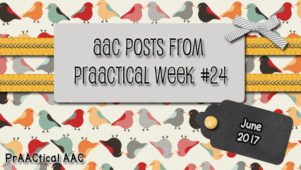
Happy Sunday, everyone! Here are some posts from our prAACtical week. Monday: PrAACtical Resources: AAC 101 Flipbook Handout Wednesday: Video of the Week: Aided Language Input in AACtion Thursday: Video of the Week: Aided Language Input in AACtion
June 5, 2017
by Carole Zangari -
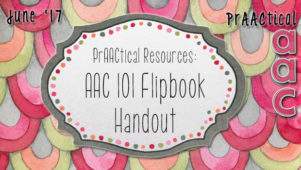
Looking for a quick, easy-to-read resource to supplement your AAC trainings with colleagues and families? In today’s post we share a flipbook-style handout that might come in handy. It covers basic tips under these headings: AAC Near Me (See me, see my AAC) Speak AAC (Aided language input) Speaking Style (Descriptive talking) Expectations (Setting the bar high) Support (AAC facilitation strategies) FAQs (Q & A about implementation) Top 10 Tips You can download the file here. Edited: This was translated into Spanish as part of the Hablando PráctiCAAmente project, coordinated by Deanna Wagner. Dianna Angeles was the translator and Claudia Marimón assisted with the editing. You can access the Spanish edition here. Enjoy!
June 4, 2017
by Carole Zangari -
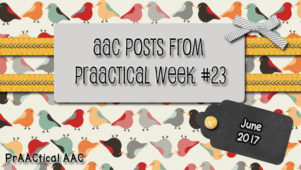
Here are some AAC posts that you may have missed in your busy week. Monday: A Thought on Memorial Day Wednesday: Video of the Week: Aided Language Input During Play Thursday: AAC in the High School Classroom: Where Core Vocabulary Meets Life Skills
June 1, 2017
by Carole Zangari -
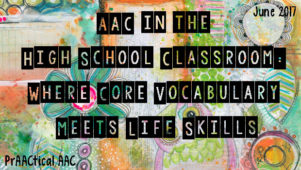
Today, guest blogger Sarah Mueller, a special education teacher in Rochester Michigan, shares her thoughts on supporting core vocabulary learning while working on functional life skills. Sarah teaches high school students with intellectual and developmental disabilities and strives to embed language and communication throughout her students’ entire school experience. Sarah helps her students become strong self-advocates as they prepare for adult life. Marlene Cummings, Sarah’s colleague and mentor, introduces the post. :::::::::::::::::::::::::::::::::::::::::::::::::::::::::::::::::::::::::::::::::::::: I (Marlene Cummings) had the pleasure of meeting Sarah 2 years ago as a new teacher in one of my districts. She immediately engaged in our county level professional learning opportunities in AAC and Literacy. The AAC focus presented strategies to support AAC and language learning including: core vocabulary, aided language input, vocabulary instruction and opportunities. The literacy focus was designed to create and implement a comprehensive literacy program taught by Drs. Karen Erickson and David Koppenhaver. The outcome:... [Read More...]
May 11, 2017
by Carole Zangari -
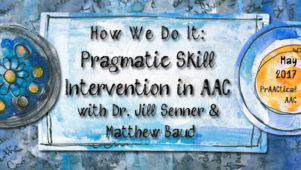
Better Hearing and Speech Month is in full swing and we are excited to see SLPs talking about tools and strategies for supporting people with AAC needs. Many individuals with AAC needs have difficulty using language in expected ways, particularly in social interactions. In this post, we welcome back guest authors Jill Senner and Matthew Baud to discuss ways in which they target pragmatic language in their clinical work. They have a prAACtical approach to this subject and are generous in sharing AAC resources, including vocabulary/pagesets for some popular AAC apps/SGDs. Enjoy! ::::::::::::::::::::::::::::::::::::::::::::::::::::::::::::::::::::: Chat with Me: Pragmatic Skill Intervention in AAC with Jill E Senner, PhD, CCC-SLP & Matthew R. Baud, MS, CCC-SLP Pragmatic skills, commonly referred to as social skills, play an important role in the successful integration of individuals with disabilities. People with disabilities need adequate social skills to live and be educated in the least restrictive environment, to be... [Read More...]
April 19, 2017
by Carole Zangari -
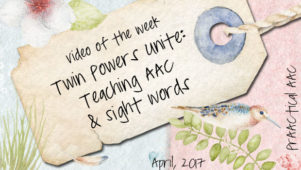
Having trouble getting AAC integrated throughout the classroom day? Veteran SLP Maureen Castillo took a creative approach to this common problem in the classrooms she supports. In this video, she discusses a project she created to foster AAC learning and use in the context of literacy activities. Learn how she combines the teaching of core vocabulary and Dolch sight words using aided language input, peer modeling, anchor books, and more. The video was made possible by Saltillo and is part of their free webinar series. Many thanks to Maureen and to Saltillo for making this available. Direct Link to Video: https://www.youtube.com/watch?v=epQ3QlBg0hs
February 27, 2017
by Carole Zangari -
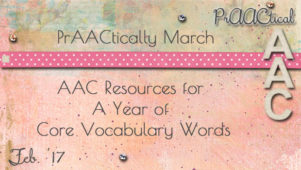
Do the AAC users in your life use only a fraction of the core words in their SGD, AAC app, or communication board? One way to help them move forward is to make a concerted effort to use, highlight, and provide additional teaching on a variety of words. It’s hard to do this without getting overwhelmed, so find a strategy that works for you. A few years ago, we decided to approach this by focusing on 12-16 core words each month. (If this is too much for the teams with whom you work, that’s not a problem. Just cut it back to 4-6 words/month.) Each month, we can highlight those words in our conversation (aided language input), direct intervention, and home programming activities with AAC learners. The repeated experiences with those 12-16 (or 4-6) words helps our AAC learners develop new skills, and keeps the team focused on the same destination. It’s... [Read More...]
February 16, 2017
by Carole Zangari -

It’s exciting to see more and more teams on the road to implementing AAC in therapy and in the classroom. Often, though, our initial expectations for student progress don’t pan out. Consider these examples. Aleksander’s SGD has robust vocabulary that is customized specifically for him. He uses it consistently at snack and lunch time, but rarely uses it in other activities. Ariel uses her AAC app to ask for things, make comments, and answer questions but rarely goes beyond the single word level to express herself. Jayson had a PECS book for over a year and learned to request his favorite foods but not much else. His team switched Jayson over to a more robust AAC system, and while he learned to communicate for other reasons, he still doesn’t use his communication book very frequently unless he’s prompted to do so. Do these situations seem vaguely familiar? Helping AAC learners become... [Read More...]
January 30, 2017
by Carole Zangari -
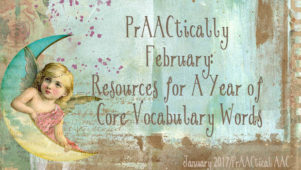
As we tick off the final days of the month, we’re looking ahead to ways we can highlight more of the core vocabulary words in our clients’ AAC devices and communication aids. One approach to boosting practice opportunities is to select a dozen or so core words to focus on each month. Throughout the month, we can then pay special attention to that small group of words by highlighting them with focused language stimulation, aided language input, and specific activities designed to teach or practice those words. In previous years, we shared lists of some core words to help you do just that and every month we share some ideas for prioritizing a small set of words. You can use these materials to remind yourself which words to highlight this month, with using aided language input and focused language stimulation. What else? Here are some ideas to get you started. Print... [Read More...]









